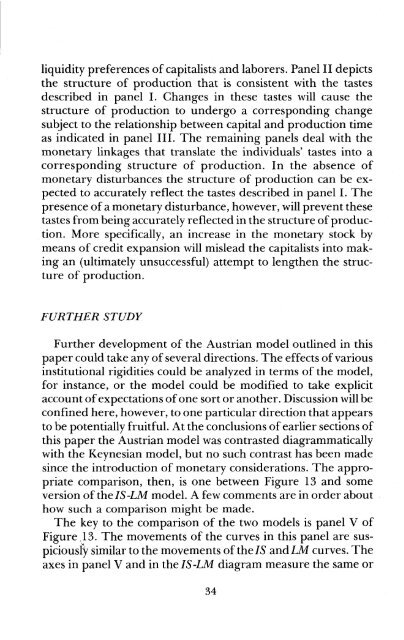Austrian Macroeconomics - Ludwig von Mises Institute
Austrian Macroeconomics - Ludwig von Mises Institute
Austrian Macroeconomics - Ludwig von Mises Institute
You also want an ePaper? Increase the reach of your titles
YUMPU automatically turns print PDFs into web optimized ePapers that Google loves.
liquidity preferences ofcapitalists and laborers. Panel II depicts<br />
the structure of production that is consistent with the tastes<br />
described in panel I. Changes in these tastes will cause the<br />
structure of production to undergo a corresponding change<br />
subject to the relationship between capital and production time<br />
as indicated in panel III. The remaining panels deal with the<br />
monetary linkages that translate the individuals' tastes into a<br />
corresponding structure of production. In the absence of<br />
monetary disturbances the structure of production can be expected<br />
to accurately reflect the tastes described in panel I. The<br />
presence ofa monetary disturbance, however, will prevent these<br />
tastes from being accurately reflected in the structure ofproduction.<br />
More specifically, an increase in the monetary stock by<br />
means of credit expansion will mislead the capitalists into making<br />
an (ultimately unsuccessful) attempt to lengthen the structure<br />
of production.<br />
FURTHER STUDY<br />
Further development of the <strong>Austrian</strong> model outlined in this<br />
paper could take any ofseveral directions. The effects ofvarious<br />
institutional rigidities could be analyzed in terms of the model,<br />
for instance, or the model could be modified to take explicit<br />
account ofexpectations ofone sort or another. Discussion will be<br />
cOll;fined here, however, to one particular direction that appears<br />
to be potentially fruitful. At the conclusions ofearlier sections of<br />
this paper the <strong>Austrian</strong> model was contrasted diagrammatically<br />
with the Keynesian model, but no such contrast has been made<br />
since the introduction of monetary considerations. The appropriate<br />
comparison, then, is one between Figure 13 and some<br />
version ofthe IS-LM model. A few comments are in order about<br />
how such a comparison might be made.<br />
The key to the comparison of the two models is panel V of<br />
Figure ,,13. The movements of the curves in this panel are suspiciousfy<br />
similar to the movements oftheIS andLM curves. The<br />
axes in panel V and in the IS -LM diagram measure the same or<br />
34

















